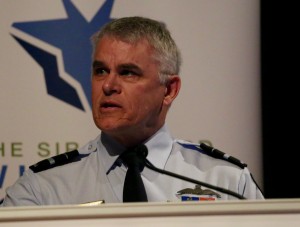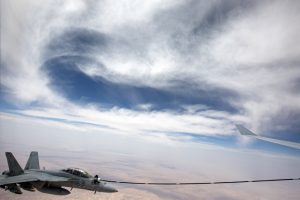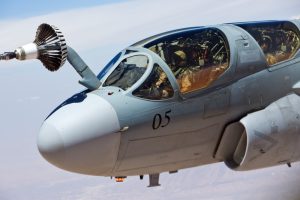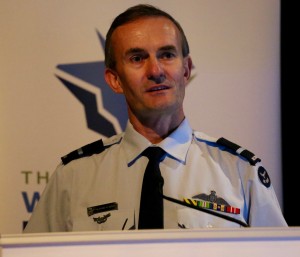2016-06-05 The RAAF KC-30A Multi Role Tanker Transport provides air-to-air refueling support to international coalition aircraft in the skies over Iraq as part of Task Group 630.
On 27 April 2016, the deployed KC-30A surpassed the milestone of delivering 50 million pounds (27 million kilograms) of fuel to receiver aircraft in theatre since it first conducted missions for Operation OKRA in September 2014.
KC-30A Refueling Milestone in Operation OKRA from SldInfo.com on Vimeo.
And the operational performance and tempo of the KC-30A was described in an interview we did earlier this year with the KC-30A test team then at Edwards AFB (made up of folks with operational experience, including the Middle East).
With a new program, generally, you crawl, walk and then run.
With this program, we needed the capability relatively quickly so we sort of crawled and then ran.
The deployment to the Middle East has rapidly accelerated our maturing of the aircraft.
We went to the Middle East in the Fall of 2014.
We operate one tanker at a time in Operation Okra and a deployment is four months.
Some airmen have already completed three or four rotations in the mission.
Even though we have only one tanker there, we are delivering more than 10% of all the fuel in the operation.
We have offloaded around 40-45 million pounds of fuel in the Middle East during the operation to coalition forces.
We are operating at 96-98 percent mission success rate, and the maintenance has been outstanding.
It is a commercial plane with military systems onboard and is built for rapid fuel intake, for commercial airlines expect to turn around planes rapidly.
They don’t make money with the plane on the ground.
We can do this as well, but are limited only by the austere conditions at military bases which slows the refueling process.
And the efficiency of the engines is outstanding which means that we burn less fuel than a KC-10 or KC-135 when flying and doing the tanking operations.
During visits to Australia and to the KC-30A team then doing certification tests at Edwards AFB, an update was provided on the tanker by the Royal Australian Air Force (RAAF)
In an interview conducted in March earlier this year, the Chief of Staff of the RAAF highlighted the role of the tanker as follows:
“For example, we are having a long conversation inside Air Force around how would you use a KC-30 better than we currently do?
Well you would integrate it.

So what does that mean for tanker?
It means that we spend a long time in the airspace providing fuel to aircraft. What’s it doing in between the refuels?
It’s flying racetracks or patterns or getting to the next place that gas is needed airborne. What’s it doing while it’s doing that? Why can’t it collect some form of ISR data to be turned to knowledge?
The legacy perspective would be to say: “No it’s an in mid-air refueler and a transport aircraft.”
The new perspective is to think about how the KC-30 can become a communications node for platforms and systems other than fighters. Perhaps you’re able to relay information to soldiers on the ground, or with regard to the new amphibious task force, perhaps you might, from a couple hundred miles off the coast, be able to relay information during the time the tanker is on station.
That makes a lot of sense to me, and a lot of it can happen without the crew having to do one extra bit of work other than provide the node.”
The Air Commander Australia, Air Vice-Marshal Gavin Turnbull, focused on the operational experience of the tanker in the Middle East in his interview.
Question: When we visited your KC-30A test team at Edwards, one of the key points driven home by the team was how important the built-in situational awareness in the aircraft to reshaping their approach to tanking in the area of interest.
How does this illustrate your evolving approach?
Answer: What we have given the tanker crew is what the fighter pilot experienced in the first decade of the 21st century.

We added Link 16 into the cockpit and suddenly they had situational awareness of the battlespace around them and could now work within the battlespace, rather than simply going to a tanker track and acting as a gas station in the sky waiting for the planes to come in to get gassed up.
This has meant changing the skill set for the tanker crew as well.
We need to have smart people with smart situational awareness combat skills rather than truck drivers. They now position themselves where they’re next needed.
They’re maintaining their awareness and they’re moving into the battle space, and the jets are coming off their targets and are surprised about how close the tanker is.
In fact, we’re starting to get the reverse complaint where pilots who are coming off targets don’t have time to think and reconfigure their airplane before they’re on the wing of the tanker getting some more fuel.
And the Air Commodore in charge of Air Mobility for the RAAF provided both an example of the performance of the tanker and its crew in the Middle East as well as an insight into the way ahead for the evolution of the tanker as well.
There was a dramatic case of where the KC-30A moved to an aircraft in trouble over the skies of Iraq.
According to Air Commodore Richard Lennon:

A USMC Hornet lost an engine, and was in danger of going down in an area where it might not be good for the pilot to land or bail out.
The KC-30A came to the Hornet and supported it as the aircraft had to fly down in a cascading pattern to get back to base.
“Link 16 can tell you where the assets are and the fuel status of the air combat force.
But it cannot tell you about intentions. You get that from listening to the chat.
In this case, the pilot was listening to the chat and discovered a problem.
He then flew to the problem.

The Marine Corps Hornet had lost an engine and could not stay level at the refueling speed, so they set up a descent pattern to work the problem.
They could not do that until they were outside of the core combat area.
They set up what is called a toboggan where you just slow the descent so the Hornet could keep up his speed to get refueled.
And of course as he transferred fuel, he got heavier which in turn made it more difficult to keep your speed up, but the tanker adjusted to the need for the Hornet.”
He then provided a perspective on the evolution of the tanker as the RAAF worked joint force integration and the platform itself evolved.
With regard to tanker, the RAAF is thinking about the future modifications of the KC-30A and clearly doing so from the Plan Jericho perspective.
This means not simply from an air-to-air perspective but from a joint perspective.
“We’re getting lots of ideas obviously from all quarters.
And it’s not just army in terms of Air-Land Integration.
It’s from air force itself and, and it’s from different quarters of the organization.

In that process we’ll start to prioritize what we need.
The number one priority might actually take three years and a lot of money to implement but we will look for low-hanging fruit as well which can be implemented and funded in a much shorter period of time as well.”
Air Commodore Lennon highlighted an important development, which Airbus was working on for the tanker.
“They are working hard on building an autonomous boom where the boom will actually work out where the receptacle is and fly itself into contact.
This will ease the workload for the tanker crew, and provide significant capabilities to fuel new assets coming to the tanker, such as UAVs.
It would be an important step forward.
If you have a good reliable autonomous system, then the boom operator is not tiring as quickly and so you can stay on station longer and enhance your persistence in the battle space.”
The video and the text at the start of the article was published by the Australian Ministry of Defence on May 23, 2016.
For an update on the Airbus Tanker from the Australian perspective which was published on 9/20/15, see the following:
https://sldinfo.com/wp-content/uploads/2015/09/Update-on-Airbus-Tanker.pdf
For the perspective of the KC-30 test team when they were at Edwards AFB earlier this year, see the following:
For the version of this article which appeared on National Interest, see the following:

